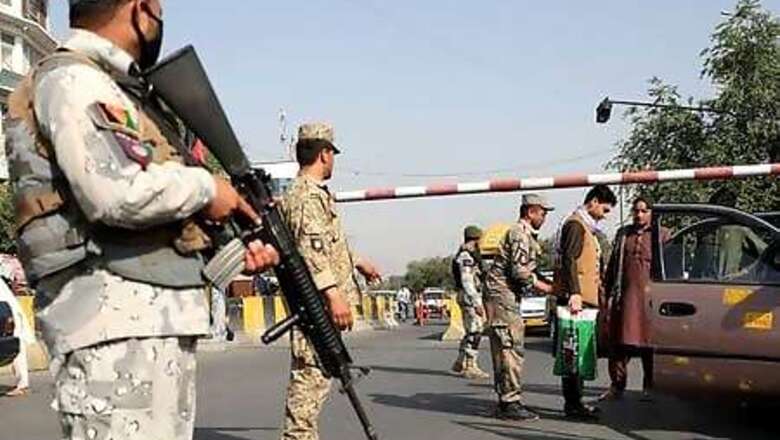
views
KABUL An Afghan grand assembly, known as the Loya Jirga, on Sunday approved the release of 400 “hard-core” Taliban prisoners, a decision endorsed by President Ashraf Ghani, paving the way for peace talks between the government and the insurgents aimed at ending a 19-year war.
Following is a chronology of U.S. involvement and major developments in Afghanistan over the past 19 years. The Afghan war has killed more than 2,300Â U.S. service members and wounded more than 20,000, while more than 100,000 Afghan civilians are estimated to have died. [L4N2FB02T]
Sept. 11, 2001 – U.S. involvement in Afghanistan is triggered by the twin suicide attacks on the United States plotted in Afghanistan by al Qaeda militant leader Osama bin Laden, a Saudi who was there under Taliban protection.
Oct 7, 2001 – U.S. forces begin air campaign with strikes on Taliban al Qaeda forces. Small numbers of U.S. special forces and CIA agents soon slip into Afghanistan to help direct the bombing campaign and organise Afghan opposition forces.
Nov. 13, 2001 – U.S.-backed Northern Alliance forces enter Kabul as the Taliban withdraw south. Within a month, Taliban leaders have fled from southern Afghanistan into neighbouring Pakistan.
December 2001 – U.S. forces bomb the Tora Bora cave complex in eastern Afghanistan where bin Laden is hiding, but he slips over the border into Pakistan and disappears.
Dec. 22, 2001 – Hamid Karzai, an ethnic Pashtun opponent of the Taliban, is sworn in as interim leader.
May 2, 2003 – U.S. officials declare an end to major combat operations in Afghanistan. President George W. Bush turns the U.S. focus to preparing for the invasion of Iraq. This allows the Taliban to gradually return, at first in the south and east.
Feb. 17, 2009 – Barack Obama, in his first major military decision as president, orders 17,000 more combat troops to Afghanistan to tackle an intensifying insurgency. The 17,000 reinforce 38,000 U.S. troops and 32,000 from some 40 NATO allies and other nations already in Afghanistan.
Aug. 20, 2009 – Second Afghan presidential election. Karzai retains power after a dispute with his main rival, Abdullah Abdullah, fuelled by allegations of major election fraud.
May 1, 2011 – Bin Laden is killed in a raid by U.S. forces in Abbottabad, Pakistan.
2011 – The number of U.S. forces in Afghanistan peaks at about 100,000 as part of a surge that involves intensified CIA drone attacks on Taliban and other militants in Pakistan.
December 2011 – U.S. officials say U.S. diplomats have held about half a dozen secret meetings with Afghan Taliban contacts over 10 months, mostly in Germany and Qatar.
Dec. 28, 2014 – The U.S. combat mission is officially concluded after the withdrawal of most combat troops and a transition to an “Afghan-led” war. Nearly 10,000 U.S. troops remain, though, with a focus on training Afghan forces and counter-terrorism.
Aug. 21, 2017 – Eight months after being sworn in, President Trump announces his administration’s new strategy on Afghanistan following a “comprehensive reviewâ€. He says the U.S. “must seek an honorable and enduring outcome†to the longest war in American history. “We will no longer use American military might to construct democracies in faraway lands, or try to rebuild other countries in our own image. Those days are now over.â€
Sep. 4, 2018 – Afghan-born U.S. diplomat Zalmay Khalilzad is appointed U.S. special representative to seek negotiations with the Taliban.
Oct. 12, 2018 – Khalilzad is reported to have met Taliban representatives in Doha, where they have set up their political office. There are said to already have been earlier meetings, including U.S. State Department officials meeting insurgent leaders earlier in July to have “talks about talksâ€.
Feb. 29, 2020 – After months of on-off talks, the United States signs a troop withdrawal agreement in Doha with the Taliban. The deal includes a 14-month timeline for the withdrawal of all U.S. and NATO troops from Afghanistan as well as guarantees from the Taliban that it will prevent militant groups including al-Qaeda from using Afghan soil to threaten the security of the United States and its allies.
April 9, 2020 – After initially resisting releasing prisoners demanded by the Taliban on security grounds, the Afghan government releases around 100 of the 5,000 demanded by the insurgent group. Over the following months it continues to release prisoners, but the process stalls at the final 400, who are accused to some of Afghanistan’s greatest crimes.
Aug. 9, 2020 – President Ashraf Ghani agrees to release the final 400 prisoners after consulting with the Loya Jirga, paving the way to peace negotiations with the Taliban in the Qatari capital, Doha.
Disclaimer: This post has been auto-published from an agency feed without any modifications to the text and has not been reviewed by an editor




















Comments
0 comment